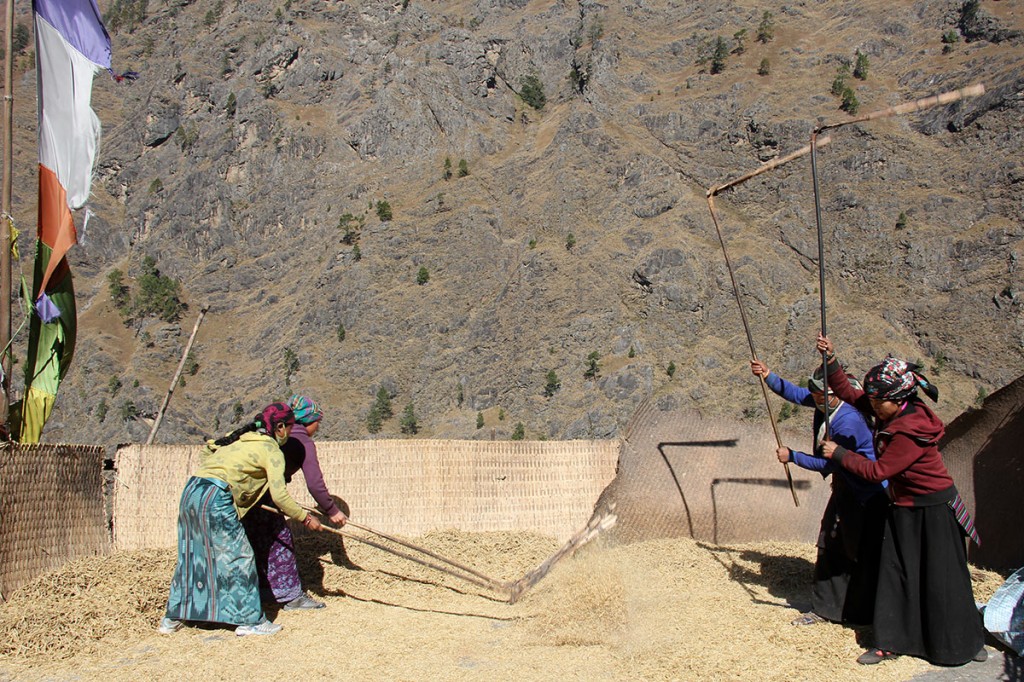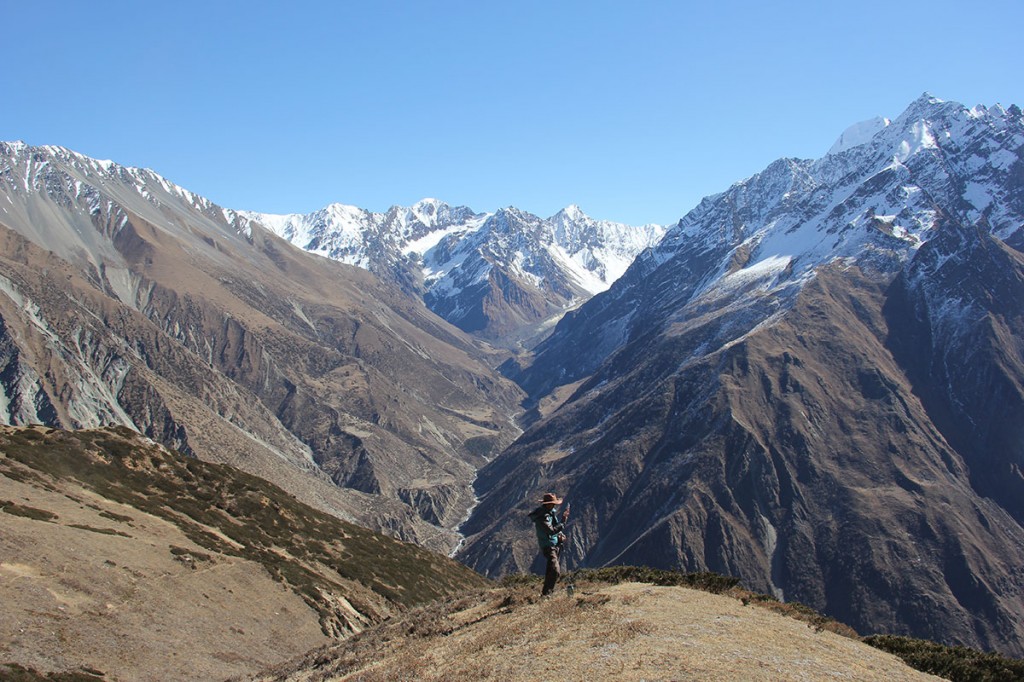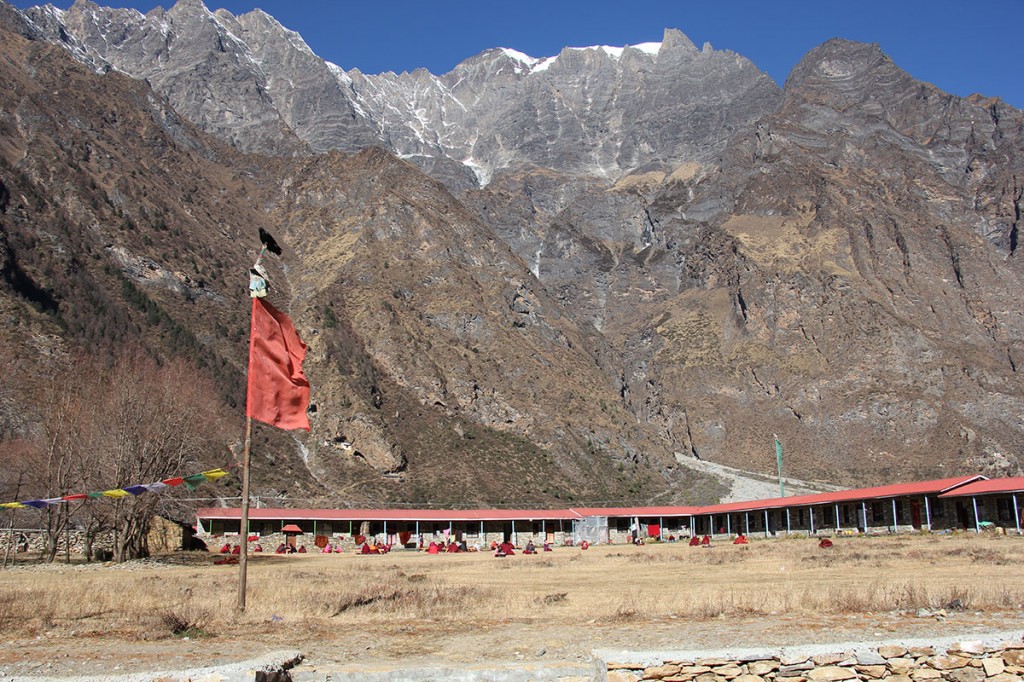Nepal’s Tsum Valley is a sacred Himalayan pilgrimage site situated in northern Gorkha province and trekking was first allowed here in 2007. It contains Tibetan villages which, due to the valley’s remoteness and inaccessibility, have been isolated from mainstream development for centuries and, as a consequence, the unique culture of Tsum Valley has remained fairly intact. Against the majestic backdrop of the Ganesh and Sringi Himals, this serene and hidden Himalayan valley is rich in ancient art, culture and religion.
The trails of Tsum Valley are strewn with artistic chortens and lined with mani walls made of thousands of stone slabs carved with drawings of deities and inscribed with prayers. The Buddhist saint Milarepa is believed to have meditated in the caves of these mountains. The famous Kyimo Lung, a pilgrimage circuit in the central Trans-Himalaya, traverses Tsum Valley, the Manaslu area and southern parts of Tibet. Tsum is considered a beyul, one of the valleys designated by the 8th Century Tantric master and founder of Himalayan Buddhism Padmasambhava as a sacred refuge for Buddhists and a place of great spiritual power.
Women in Tsum Valley still practice polyandry (having more than one husband) and the people have their own culture, dialect and traditions, celebrating unique festivals like Lhosar, Dhacyhang, Saka Dawa and Faning.
Many residents of Tsum Valley report that they have seen or found signs of Mehti, more commonly known as the Yeti, so here’s your chance for the photo of the century.
This is a non-difficult camping or tea-house trek best done during October to November, but it could equally well be done from late February to early May. The upper valley itself has a more Tibetan climate and is probably at its best in June to September, but the long trek there during the monsoon is a hassle. The first 4½ days of this trek are the same as the Manaslu Circuit.
For an external web-site about the monasteries in the valley try here; the Tsum Project.
If you have an additional 2 days to spare a great alternative is to start the trek at Manakamana and trek from there to Gorkha and then spend a day hiking from Gorkha to Arughat. This is both a fascinating stretch that other trekkers don’t see and a good opportunity to get fitter before you start ascending.
| Day 1 | Kathmandu to Arughat (535m) Your trekking guide will arrive at your hotel and, after breakfast, we drive from Kathmandu to Arughat Bazaar by the Buri Gandaki River. (7 hour drive). |
| Day 2 | Arughat Bazaar to Soti Khola (710m) We trek through Gurung and Magar villages, alongside the river through bird-filled forests with monkeys and waterfalls, to Sante Bazaar with its overhanging pipal tree. It can be hot and humid and rice, maize and millet are the main crops here. We hike up stairs as the valley becomes wilder, prettier, steeper and narrower as we trek into Arkhet. We hike through fields, over a ridge, down to a waterfall up to a ridge at Kyorpani and trek down to Soti Khola (river) (710m), where there’s a swimming hole popular with locals. This Gurung part of the valley is famous for its bees and honey. (6 hour trek). |
| Day 3 | Soti Khola to Machha Khola (930m) From Soti Khola the trek passes through forests of sal trees en route to Khursane. From Khursane we hike up, past 2 waterfalls cascading down and emitting fine spray through which the light forms spectacular rainbows, on a steep trail clinging to the cliff face. We’re now starting to trek into the spectacular Buri Gandaki Gorge and the hike seems to go up and down faster than… you can blink. Finally the trek winds its way past rice terraces to the Gurung village of Lapubesi. After a brief hike up the valley widens and the river meanders to the village of Machha Khola. (5 hour trek) |
| Day 4 | Machha Khola to Jagat (1,410m) We trek on up and down and hike across sandy river-flats, the monkeys and langurs in the jungle above can knock rocks down, so watch out. The large Gurung villages are way above and the trek passes few houses (lower Khorlabesi was largely destroyed by a huge rock slip years ago, though a survivor has built a botanic garden and a lodge from which he sells his organic coffee). Goat-herders passing through this area wear the distinctive smoke-browned capes called bokkhu made famous in the book “Honey Hunters of Nepal” and featured in a BBC documentary “Jimmy and the Wild Honey Eaters”. We trek on up and down over a couple of ridges to Tatopani (930m), where there are hot water spouts and a washing area under the sheer cliffs. We hike over a ridge and cross the Buri Gandaki on a rickety suspension bridge, hike up marble stairs in the narrow valley and trek through Doban (1,000m). After an hour there is a large rock where we can take tea and look at the wild gorges ahead. Hiking across a landslip and then a bridge over the Yaru Khola (1,363m) we trek onto river-flats at Yaru (1,140m), where we should look downstream and notice the massive rockfall that chokes the river. Just past Yaru we hike over to the left bank and enjoy an easy up and down trek to Jagat (1,410m), a pretty flag-stoned Gurung village. In this area, potato, maize and climbing beans are all planted at the same time – the potato for food and to suppress weeds, the maize for food and to supply a trellis for the beans, an important source of protein – marijuana is a major weed here. (6 hour trek). |
| Day 5 | Jagat to Lokpa (2,240m) We trek up the riverbed and hike over a rocky ridge to Salleri (1,440m) catching magnificent views of Sringi Himal (7,187m) and then trek down to Sirdibas (1,430m), where we’ll see our first signs of Buddhist culture. We trek on up-river before crossing Nepal’s longest suspension bridge and making a tiring hike up to the prosperous Gurung village of Philim (1,590m) set amidst fields of maize, potato and millet and groves of alder, azure pine, poplar and oak. We trek north through some pretty forest with views up the narrowing valley. After an hour we trek through Ekle Bhatti (1,600m) then hike high above a spectacular gorge entering a largely uninhabited area of pine trees. We trek down to a trail junction, hike up through pines and rhododendrons, then trek up some zigzag steps and gain our first glimpses of the Tsum Valley. Across the Buri Gandaki, above steep cliffs, is Himalchuli (7,893m). We trek through a peaceful undisturbed temperate forest into Lokpa and its adjacent barley fields. We have entered the Tsum Valley. (6 hour trek). |
| Day 6 | Lokpa to Chumling (2,363m) We trek down through beautiful alder, blue pine and poplar forest, hiking across streams on bridges and circle under a huge bluff on the river before trekking steeply up. We hike through pines and rhododendrons, still climbing, as the hidden valley of Tsum stretches enticingly ahead. We eventually trek down to a lone bhatti (tea-house) beside the Shiar Khola. The trek climbs steeply to Ripchet (2,470m) and we hike cross the river on a wooden bridge and trek up. After less than an hour we hike into Chumling. Make sure you explore Chumling and check out the old gompa (Tibetan monastery), the traditional houses, orchards and beautiful stone streets. This is Buddhist agriculture with conical pine needle haystacks among the prayer flags and from here on trails are lined with chortens and mani walls made of thousands of stone slabs carved with deities and prayers. (3/4 hour trek). |
| Day 7 | Chumling to Chhokangparo (3,010m) Leaving Chumling we watch out for troops of monkeys. We trek through rich farming land of maize and potatoes which are protected from animals (yetis?) by high stone walls. The houses are classic Tibetan with bundles of firewood on the roofs and there are mani walls and kanis (stone arched gateways) along the trek. We hike cross a huge slip which is now covered with a forest of new trees. Up the valley, to the east, are superb views of the 7,422m Ganesh Himal, of long suspension bridges on the opposite bank and, far above, the perched village of Ripchet (2,468m). About 2 kms before Chhokangparo the trek passes through one of the most beautiful villages in the Tsum Valley, Ngakyu-Leru, a compact settlement with narrow alleys uniquely walled by fire woods. Across the river and Langju moraine lies the spectacular Chi-Phu monastery constructed on the edge of a rugged mountain, the trek to this monastery is tricky. We hike across the Serpu Khola and the trek enters Upper Tsum and the large village of Chhokangparo (3,010m) with its stone houses nestled under cliffs. The valley here has spacious fields of barley, maize, buckwheat and potato and herds of Himalayan tahr, which graze the wild cliffs to the north, sometimes descend to the fields. Take time to explore the conjoined villages of Chhokang and Paro and hike up to the retreat where Lama Kongchog died after 26 years of meditation. His child reincarnation, found in the village though now studying in the US, was subject of the award-winning DVD “Unmistaken Child” (available in Kathmandu). If the air is clear Himalchuli (7,893m) can be seen down valley. (5 hour trek). |
| Day 8 | Chhokangparo to Mu Gompa (3,700m) We trek through small villages, climb over a ridge of chortens through flat fields. We visit the atmospheric Milarepa’s Cave, where a Milarepa’s footprint can be seen and the bringer of Buddhism to Tibet is reputed to have meditated. We hike across the Shiar Khola, note the fab views from Polgang hillock, trek past a stupa with glancing eyes and a gilded pinnacle, to which old women from nearby villages come for morning and evening prayers, and hike into Chhule through an impressive kani. The children here all wear chubas, traditional Tibetan dress, and there are many yaks. We trek upstream to cross the bridge and hike up to Nile, the last village heading north in the Upper Tsum Valley. Both villages are in traditional style with livestock compounds in the houses and sheltered verandahs for drying crops. From a distance Nile appears to be an island in the Shiar Khola. The valley is fertile and has large houses. From here the trek gradually ascends to Mu Gompa, the largest monastery in the area and the highest and farthest habitation in the Tsum Valley. (7 hour trek). |
| Day 9 | Mu Gompa (3,700m) From Mu Gompa we can trek upward for a view or press on up the steep gorge to Kalung (3,820m), from where, surrounded on 3 sides by Tibet we can either trek east across spectacular, if windy, yak pastures to Pama and Ngula Dhojyang (5,093m) or west to Thapla Bhanjyang (5,104m). Extensive seasonal yak pastures extend in all directions, the Lungdang Glacier is to the east and there are high peaks all around. NB the Chinese Army control these passes which should not be approached without a Nepali government permit to be in the border area and a guide. (9 hour trek). |
| Day 10 | Mu Gompa to Rachen Gompa (3,240m) We trek downhill to visit Rachen Gompa nunnery, the female equivalent of the main Kathmandu Kopan Monastery, with its huge courtyard. (4 hour trek). |
| Day 11 | Rachen Gompa to Gumba Lungdang (3,200m) We hike back to Chhokangparo, following the previous trek for 2 hours until a small gompa is reached at Gho (2,485m), before hiking down to the Shiar Khola and crossing the river to Dumje, a hamlet of 8 scattered houses and a Tibetan herbal medicine clinic and school. The land here is good for cultivating barley. From Dumje we hike steeply up through gorgeous forests of huge silver pines and rhododendrons to reach Gumba Lungdang (3,200m), the oldest nunnery in the valley, perched on a ridge with spectacular views. This small gompa with 40 nuns has an intense puja from 6 to 7.30 every evening. Scattered along the terraces are about 16 houses occupied by worshippers and nuns. The main building of the nunnery houses murals of many Buddhist deities and life-size statues of Guru Padmasambhav, Yara and Buddha. (7 hour trek). |
| Day 12 | Day trip via Ganesh Himal Base Camp We zigzag to regain the lower track and trek up valley on an indistinct rocky trail through the forest. We hike across the Laudang Khola on a rickety wooden bridge and trek steeply up through pristine pine and rhododendron forest to a ridge. We hike up a birch-lined dry creek and eventually trek onto grassy flats behind the lateral moraine of the Toro Gompa glacier. We hike up past seasonal yak huts and find a track on the moraine wall that gives superb views of the mountains, Ganesh Himal Base Camp is here. The intact forest wilderness and views make this an outstanding side-trek. (7/8 hour trek). |
| Day 13 | Gumpa Laundang to Ripchet (2,470m) We trek down from Gumpa Lungdang to Dumje, hike across the Laudang Khola, trek over some very deep gorges and shaky bridges to picturesque Ripchet. Take time to look around this fertile valley of barley and buckwheat with evocative chortens and mani walls in the fields and a pine forest backdrop. (5 hour trek). |
| Day 14 | Ripchet to Dobhan (1,070m) We hike down on steep stairs to the river at Ghumlong (2,130m), which we trekked through 6 days ago. We trek up again through the pristine temperature forest and then hike down past Lokpa and Jagat to Dobhan. (7 hour trek). |
| Day 15 | Dobhan to Soti Khola (720m) We continue our return trek, this time seeing things from a different angle, both literally and metaphorically. (5 hour trek). |
| Day 16 | Soti Khola to Arughat (535m) We make the final leg of our trek. (4 hour trek). |
| Day 17 | Arughat to Kathmandu We drive back to Kathmandu. (7 hour drive).
We hope you’ve had a great trek, seen a bit of the world that you never dreamt you’d see, had some adventures, tightened your belt a few notches and we look forward to trekking with you again on your return to Nepal. |
| Price | US$ 1,600 plus accommodation in Kathmandu. This price is valid for both tea-house and camping treks, though with a minimum of four campers, less would cost more per camper. |
| Price includes | Airport pick-up and drop off, all inclusive trek costs; all camping equipment, breakfast, lunch, dinner, trekking and park permit fees, guide and necessary porters and all their costs such as transportation, accommodation, food, equipment, insurance etc. |
| Price excludes | Food and accommodation in Kathmandu, alcoholic drinks, tips, your insurance and personal expenses. |









































Leave a Reply
Want to join the discussion?Feel free to contribute!